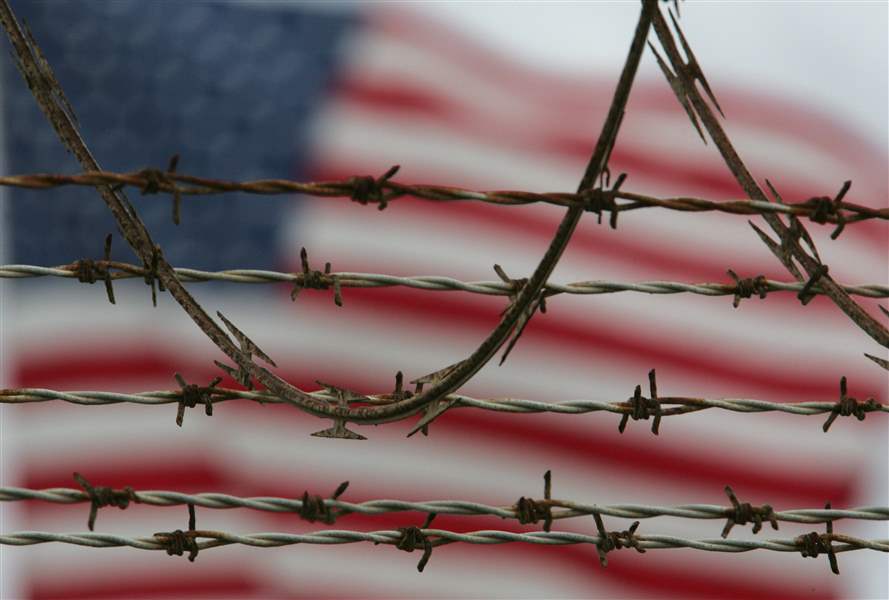
The enduring blight of Guantanamo Bay
2/9/2018
A flag waves behind the barbed and razor-wire at the detention compound on Guantanamo Bay U.S. Naval Base in Cuba.
ASSOCIATED PRESS
During his recent State of the Union address, President Donald Trump made a formal announcement of his decision to keep the controversial Guantanamo Bay detention center open. This is merely the latest entry in the prison’s 16-year lifespan, one that continues to be surrounded by political contention and important legal questions.
The detention center, which is made up of several military prison facilities, was established in 2002 by President George W. Bush’s administration, as a part of the War on Terror. Since its opening, nearly 800 men have been brought to Guantanamo, nearly all of whom were never brought to trial. Many of the detainees have been released for various reasons, but at last report there are still 41 prisoners being held at Guantanamo.
During the 2008 presidential campaign, Barack Obama promised to close the prison at Guantanamo Bay. On his second day in office, Mr. Obama signed an executive order requiring that the prison be closed within one year.
Yet, Guantanamo Bay remains open — at a cost of $445 million a year — and Mr. Trump’s recent executive order ensures it will not close anytime soon.
So what happened? Is Guantanamo Bay really “legal, safe, humane,” and consistent with the law, as Mr. Trump’s executive order states? Or does it remain one of the places where, as Mr. Obama noted in 2007, “we have compromised our most precious values”?
Mr. Obama’s desire to see the prison closed was opposed by elements within the Defense Department and a bipartisan congressional coalition. Deciding that it would be political suicide to press the issue of closure, Mr. Obama’s administration instead encouraged detainees to file writs of habeas corpus in order to earn a release, a tactic that was successful about 40 percent of the time.
The detention facilities at Guantanamo Bay had been initially described by former Secretary of Defense Donald Rumsfeld as a place where the U.S. government could keep “the worst of the worst.” Not surprisingly, controversy surrounded the decisions to release detainees, since there was widespread belief, within and without the U.S. government, that these men had posed a serious threat to national security.
Advocates of extending the detention of the prisoners held at Guantanamo typically cite the case of Abdallah al-Ajmi, a Kuwaiti citizen who was captured by the U.S., detained at Guantanamo, released by a Bush-era military tribunal, and then conducted a suicide bombing that killed 13 Iraqi policemen.
During the Obama-era, critics of the policies under which detainees were released from Guantanamo cited unsubstantiated figures indicating that 30 percent of those released from the prison had been “confirmed of re-engaging” in terrorism. But the one specific example routinely cited was that of al-Ajmi.
A number of the remaining detainees are being held under what many critics of the policy regard as dubious circumstances.
Information on a number of the facilities and how they are used is classified, but various leaks and reports over the years have revealed rampant abuse, including torture and other human rights violations. These acts have included waterboarding, sleep deprivation, physical beatings, forced “rectal feeding,” and more.
For example, Abu Zubaydah has been held by the U.S. government since 2002 and has been detained at Guantanamo Bay since 2003. Mr. Zubaydah was captured because of an alleged relationship to al-Qaeda. He was believed to be a “high-value detainee,” holding vital information about the terrorist group.
Mr. Zubaydah was then subjected to torture — he was once waterboarded 83 times in a month, videotapes of which were destroyed by the CIA — and has suffered, according to his attorney Joseph Margulies, a complete mental collapse.
In 2009, the CIA privately acknowledged that Mr. Zubaydah was not actually a high-level al-Qaeda operative, and that he was “not even a fighter.” Despite this, he remains imprisoned, but he has never been charged with a crime.
Read last week’s column by Will Tomer
Mr. Trump has made it clear that he views Guantanamo Bay as an asset. During his campaign, he promised to keep it open and even expressed a desire to reinstate waterboarding regardless of its effectiveness or legality.
The desire to stop terrorists from attacking American citizens is a reasonable one, but when the methods used to stop terrorists include inhumane, cruel, and illicit means, the U.S. undermines its core principles: freedom, due process, and the rule of law.
It is important to acknowledge that some of the prisoners housed at Guantanamo, such as 9/11 mastermind Khalid Sheikh Mohammed, are serious threats to our national security and should be imprisoned. But they should receive that punishment only if they are convicted by a court that determines their guilt in full accord with our standards of justice.
Given the open-ended nature of the War on Terror, in which the U.S. combats multiple organizations not backed by any one state or leader, policymakers have regularly opted for courses of action based on political expediency.
But now, nearly two decades into this conflict, it is time for our leading lawmakers, jurists, and experts on constitutional law to come together and begin the process of formulating anti-terrorism policies that are consistent with U.S. laws and the principles on which they are based.
Mr. Trump wants to keep the detention facilities open, but the leaders of the House and Senate are free to differ, and also free to begin the process of restoring “our most precious values” by recognizing the right of the detainees at Guantanamo to due process and taking the steps necessary to close the detention facilities permanently.
Contact Will Tomer at wtomer@theblade.com, 419-724-6404, or on Twitter @WillTomer.